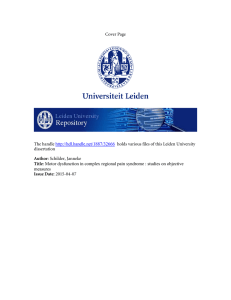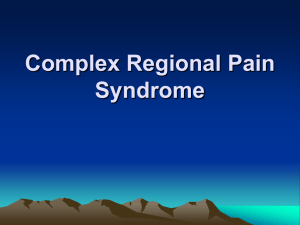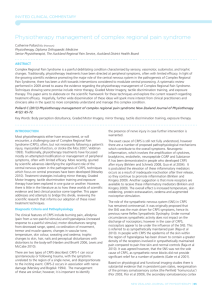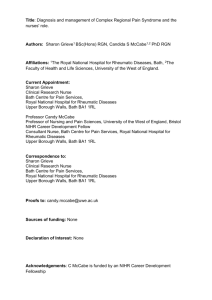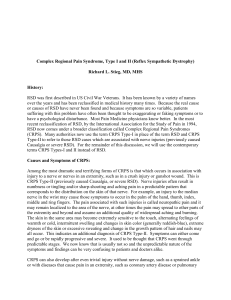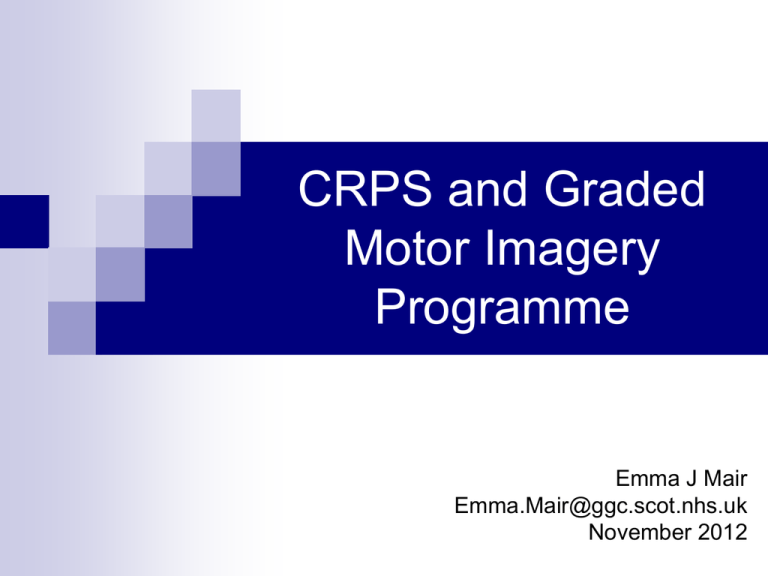
CRPS and Graded
Motor Imagery
Programme
Emma J Mair
Emma.Mair@ggc.scot.nhs.uk
November 2012
Tonight- an overview
Aetiology
Pathophysiology
UK Guidelines
Diagnosis
Treatment
Graded Motor Imagery
programme
European Incidence rate of 26/100,000
person-years
Incidence
with age till 70
60% in upper limb, 40% in lower limb
Approximately 15% of sufferers will have
unrelenting pain and physical impairment
2 years after CRPS onset
Cause Unknown
45% following fracture
18% following sprains
12% following surgery
<10% spontaneous
CRPS-1
Type
1: sympathetically maintained pain
can start for no apparent reason but most
commonly follows distal radial fracture.
Characterised by pain which is
disproportionate to inciting event, swelling,
autonomic and motor disturbances,
changes in skin blood flow
CRPS-2
Type
2: Onset develops after injury to a
major peripheral nerve. May occur
immediately or be delayed for several
months
Most commonly involved are the median
and sciatic nerves
Allodynia and hyperalgesia occur but not
limited to the territory of one single
peripheral nerve
1 + 2 = CRPS
Pathophysiology
Multi-factorial
Other factors: environmental, genetic,
psychological
The stereotyped stages are now obsolete
A definition of recovery has not yet been
agreed
CRPS is not associated with a history of
pain preceding psychological problems, or
with somatisation or malingering
Ipsilateral cortical
changes
↓Inhibition and
↑excitation in M1
Contralateral cortical changes
Reorganisation of sensory
maps in S1*
Reorganisation of motor
maps in M1†
↓Inhibition and ↑excitation
in M1 and SMA
↓Endogenous pain
control
Pain
Central sensitisation
Allodynia, hyperalgesia,
secondary
hyperalgesia, and wind-up
Sympathetic–
afferent
coupling
Pain
↓Sympathetic outflow
Vasodilation (early stage)
Endothelial dysfunction
↓NO and ↑ET-1
Impaired circulation (chronic stage)
Peripheral sensitisation
↑IL-1β, IL-6, TNFα, NGF, CGRP,
substance P, and bradykinin
Pain, vasodilation of the
skin, and oedema
• Swelling
• Glossy skin
• Increased nail and
hair growth
• Hyperaemia‡
•Sensory abnormalities
•Autonomic dysfunction
•Neurogenic inflammation
•Motor abnormalities
•Sensitisation
•Central reorganisation
Risk Factors
ACE inhibitors
Asthma
Migraine
Immobilisation
? Genetic
UK Guidelines
Published April 2012
Recommendations for assessment and management
Speciality Guidelines:
Primary Care
Physio & OT
Orthopaedic Practice
Rheumatology, neurology and neurosurgery
Dermatology
Pain Medicine
Rehabilitation Medicine
Long-Term support in CRPS
Available from: http://www.rcplondon.ac.uk/resources/complex-regionalpain-syndrome-concise-guideline
Diagnosis
Physio’s probably best equipped to identify
a patient with CRPS
Confirmation of diagnosis based on
Budapest guidelines
Confirmation with GP/cons
Differential diagnosis
Diagnosis tool:
http://www.trendconsortium.nl/diagnosis/
A The patient has continuing pain which is disproportionate to any inciting event
B The patient has at least one sign in two or more of the categories
C The patient reports at least one symptom in three or more of the categories
D No other diagnosis can better explain the signs and symptoms
Category
Sign (you can see or
feel a problem)
1. SENSORY
Allodynia (to light
touch and/or temp
sensation and/or
deep somatic
pressure and /or
joint movement)
and/or hyperalgesia
(to pinprick)
2. VASOMOTOR
Temperature
asymmetry and/or
skin colour changes
and/or skin colour
asymmetry
3. SUDOMOTOR/
OEDEMA
Oedema and/or
sweating changes
and/or sweating
asymmetry
4. MOTOR/
TROPHIC
Decreased range f
motion and/or motor
dysfunction
(weakness, tremor,
dystonia) and/or
trophic changes
(hair/nail/skin)
Symptom (the
patient reports a
problem)
Hyperesthesia does
also qualify as a
symptom
Temp asymmetry
must be >1°C
All A-D must
apply
Sensory
Alloydnia – pain due to a stimulus which does not
normally cause pain. E.g. touch and temperature
Hyperalgesia– increased response to stimulus that is
normally painful
Hyperesthesia– increased sensitivity to stimulation
Hyperpathia- a state of exaggerated and very painful
response to stimulation especially repetitive stimulus
Hypoesthesia- a reduced sense of touch or sensation,
or a partial loss of sensitivity to sensory stimuli sensory.
Vasomotor
Temperature asymmetry
Skin colour changes
Sudomotor / Oedema
Oedema
Sweating changes or asymmetry
Motor / Trophic
Decreased range of
movement and/or
Motor dysfunction
(weakness, tremor,
dystonia) and/or
Trophic changes (hair,
nails, skin)
Body Perception Disturbance
DISLIKE
DISOWNERSHIP
DESIRE TO
AMPUTATE
DISTORTED
MENTAL
VISUALISATION
Body Perception Disturbance
General Screening:
Targeted
questioning
Emotions
2. Sense of belonging
3. Perceived size
1.
Simple observation of
position of limb
The Bath CRPS Body Perception Disturbance Scale*
Developed by Jennifer S. Lewis, The Royal National Hospital for Rheumatic Diseases
Bath, England. v2. ©2008. All rights reserved.
Patient name ________________________ Date ________ Assessment no. 1 2 3 4 5
Diagnosis___________________________ Date of symptom onset____________
Body part affected: 1)_________________________
2)_________________________
3)_________________________
1) On a scale of 0-10 how much a part of your body does the affected part feel?
Very much a part = 0__1__2__3__4__5__6__7__8__9__10 = Completely detached
2) On a scale of 0-10 how aware are you of the physical position of your limb?
Very aware = 0__ 1__2__3__4__5__6__7__8__9__10 = Completely unaware
3) On a scale of 0-10 how much attention do you pay to your limb in terms of
looking at it and thinking about it?
Full attention = 0__ 1__2__3__4__5__6__7__8__9__10 = No attention
4) On a scale of 0-10 how strong are the emotional feelings that you have about
your limb?
Strongly positive = 0__ 1__2__3__4__5__6__7__8__9__10 = Strongly negative
5) Is there a difference between how your affected limb looks or is on touch
compared to how it feels to you in terms of the following:
Size yes no Comment ________________________
Temperature yes no Comment ________________________
Pressure yes no Comment ________________________
Weight yes no Comment ________________________
6a) Have you ever had a desire to amputate the limb? Yes No
6b) If yes, how strong is that desire now?
Not at all = 0__ 1__2__3__4__5__6__7__8__9__10 = Very strong
Desired amputation site________________________________
7) With eyes closed describe a mental image of your affected and unaffected
body parts (drawn by assessor during patient description then verified by the
patient)
This is an accurate account of my image of my affected body part.
Signature __________________________________ Date____________________
The Environment
Therapy environment – breezes, open windows,
fans
Lighting
Invasion of personal space
Therapist movement and language (“your” vs
“it”)
Other people nearby
Noise
Privacy
Treatment
Prompt diagnosis and early
treatment are considered best
practice
Aims of treatment:
Reduce
pain
Preserve or restore function
Enable patients to manage their
condition
Improve quality of life
Primary Care Physiotherapy &
Occupational Therapy
Best practice recommendations
Be aware of CRPS and identify the clinical signs
Be aware of the Budapest criteria for diagnosing
CRPS
Initiate treatment as early as possible
Provide patient education about the condition
Know of the nearest MDT pain service or CRPS
centre
Recognising non-resolving or moderate
symptoms for onward referral
Rehabilitation Algorithm
Identify CRPS
signs and symptoms
Consider
Differential Diagnosis
Mild/Moderate
symptoms
Meet Budapest
criteria
Consider
yellow flags
Confirm Diagnosis
Via GP or consultant
Moderate/ severe
symptoms
Educate, commence
treatments
Failing to respond
to treatment in 4 weeks
Noticeable response to
Treatment within 4 weeks
And ongoing improvement
Educate, refer via GP
To specialist pain clinic
Pain Management
programme
Pain Medicine and
Interdisciplinary Specialist
Rehabilitation Programmes
Four Pillars of Treatment
Physical and
vocational
rehabilitation
Pain relief
(medication and
procedures)
Psychological
interventions
Patient information
and education to
support selfmanagement
Engagement: education and
information for the patient &
family
Understanding pain and CRPS
Learning self management principles
Self efficacy- the patient remains
responsible and involved
Empowering the patient and the family
Medical Management
Investigation and confirmation of diagnosis
Pharmacological intervention to provide a
window of pain relief
Reassurance that PT and OT are safe and
appropriate
Provide medical follow up
Support any litigation/ compensation claim
Pain Medicine Guideline
Recommendations
No drugs are licensed to treat CRPS in the UK
Neuropathic drugs should be used in according to NICE
& IASP guidelines
Pamidronate (single 60mg intravenous dose) should be
considered in suitable patients with less than 6mths
duration as a one off treatment
Intravenous regional sympathetic blocks with
guanethidine should not be routinely used
Other additional drugs demonstrate efficacy but a lot of
the evidence is still preliminary
Spinal Cord Stimulators
Psychosocial and behavioural
management
Psychological intervention is based on individualised
assessment, to identify and proactively manage any
factors which may perpetuate pain or disability/
dependency including:
Mood evaluation- management of anxiety and
depression
Internal factors, eg counter productive behaviour
patterns
Any external influences or perverse incentives
It usually follows principles of CBT delivering:
Coping skills and positive thought patterns
Support for family/carers
Physical Management
Emphasis should be on restoration of normal function
and activities through acquisition of self management
skills, with the patients actively engaged in goal setting
The programme may include elements of chronic pain
management including:
General body re-conditioning through graded
exercise, gait re-education, postural control
Restoration of normal activities, including self care,
recreational physical exercise and social/ leisure
activities
Pacing and relaxation strategies
Vocational support
It may also include specialised techniques
to address altered perception and
awareness of the limb, for example:
Self
administered desensitisation with tactile
and thermal stimuli
Functional movement to improve motor
control and limb position awareness
Graded motor imagery, mirror visual
feedback, mental visualisation
Management of CRPS- dystonia
Activities of ADL and societal
participation
Support graded return to independence in ADLs
and clear functional goals
Assessment and provision of appropriate
specialist equipment to support independence
Adaptation of environment
Extend social and recreational activities in and
outside the home
Workplace assessment/ vocational re-training
Overview
Understand
Recognise
Prompt diagnosis
Educate
Early treatment
MDT approach
CRPS Treatment
Explain & Educate
Mindfulness /
Awareness
Problem Solving
Reducing Threat
Treatment- what are the options?
Based
on evidence based practise, guidelines
and innovative clinicians
Good quality evidence for graded motor
imagery(GMI) combined with pharmacological
management is the most effective
Educate, educate, educate
About CRPS
About Pain
We do not know why some
people get CRPS and
others don’t
We DO know that it is not
because of psychological
frailty or abnormality
Several important changes
in the brain seem to
accompany CRPS
To normalise these
changes, we have to
identify ALL combinations
to perceived threat and
train the brain
Movement versus Pain
Remember pain science and
pathophysiology
Sensitisation of CNS
More harm than good?!
Desensitisation
Activities of daily living
Washing and
dressing
Sensory
Discrimination
Two-point
discrimination
Electrical Stimulation
Graded Motor Imagery
Sequential activation
of cortical pre-motor
and motor networks
Laterality and
Imagery = pre motor
Mirror Therapy =
Primary Motor Cortex
and S1 cortices
?reversal of cortical
reorganisation
Limb Laterality
What do you see?
Right or Left?
Right or Left?
Laterality Recognition
Make a quick decision
about the laterality
then you mentally
rotate mental
representation of the
limb into the position
viewed to confirm
initial selection!
Limb Laterality Recognition
Pain affects the brains ability to recognise
laterality of images of limbs
Information processing bias
Working body Schema
“Normal Scores”
Accuracy of 80% and above
Speed of hands and feet ~ 2 seconds
Accuracies and RT should be equal
Differences in Speed
Identifies problems with
Information processing
… but what does that
mean?
Mentally
move
LEFT
hand
Acute LEFT hand
injury looking at
RIGHT hand
Difficult decision,
safest to presume
its LEFT hand
because my LEFT
hand is injured,
chose LEFT hand.
Mentally
move
RIGHT
hand
RT
R>L
X
correct
Wrong
choice,
start
again
Accuracy
L=R
Acute LEFT hand
injury looking at
LEFT hand
Difficult decision,
safest to presume
its LEFT hand
because my LEFT
hand is injured,
chose LEFT hand.
Mentally
move
LEFT
hand
correct
Acute Pain
Mentally
move
RIGHT
Chronic LEFT
hand injury
looking at RIGHT
hand
Difficult decision,
safest to presume
its RIGHT hand
because my LEFT
hand is in trouble
and I’m protecting it
by not focusing on it.
Mentally
move
LEFT
hand
hand
RT
L>R
X
correct
Wrong
choice,
start
again
Accuracy
L=R
Chronic LEFT
hand injury
looking at RIGHT
hand
Difficult decision,
safest to presume
its RIGHT hand
because my LEFT
hand is in trouble
and I’m protecting it
by not focusing on it.
Mentally
move
RIGHT
hand
correct
Chronic Pain
Why?
Incorrect
selection leads to longer
reaction time as need to repeat
mental rotation of limb to confirm
laterality choice
Pain & information processing,
patients wrongly select
Differences in Accuracy
Difference in accuracy
suggests issues with the
working body schema
Why?
Cortical reorganisation
Easier access to painful working body
schema?
Laterality Reconstruction
Hands, Feet, Neck/Shoulder
Vanilla, Abstract, Context
Online and Flash cards
Recognise Phone Apps
Other methods:
Shadow
Puppets
Digital cameras
Magazines
Recognise
Recognise online:
http://recognise.noigroup.com/recognise/
Motor Imagery
Motor Imagery
Sports Performance
Neuro-Rehabilitation
Cognitive Psychology
Graded Motor Imagery
Motor Imagery
Observing and
Imagining movements
Imagining yourself
doing the movement
not imagining
observing themselves
doing the movement
The Why?
If you can’t feel it, how can
you use it?
The What?
Patient Explanation
Food
Back
pain & bending
The How?
Prompts:
Shape
Skin
Colour
Digits
Movement
Motor Imagery
Awareness of body
part
Imagining movements
Imagining functional
activities
Flash cards and online
images can be used
as prompts
Mirror Therapy
The Why?
Illusion
Tricking the brain
Motor Cortex / S1
Mirror Neurons
The How?
Observation
De-sensitisation
Movement
Context- emotional, threat
Weight bearing
Functional rehab
Mirror Therapy
Practical:
Try
bilateral movements with the mirror
Try asynchronous movements whilst watching
your limb in the mirror
Get someone to tap or stroke the unaffected
limb whilst looking at the reflected limb
Mirror therapy for the 21st century?
Prism Glasses
www.prismglasses.co.uk
Brain Training
Educate
Desensitise
Habituate
Develop Function
Can’t Perform
Bilateral synchronised
movements in a mirror
Mirror visual feedback
? Physical rehabilitation
approaches
Can’t Perform
Imagined movement of
affected limb
Can’t Perform
Rehearse motor imagery
Can’t Perform
Limb Laterality
Can’t Perform
Limb Laterality programme
Can’t Perform
Can’t Perform
Sensory discrimination
Electrical or manual
Concurrent medical and psychological support
Resources & Research
Questions from you and from
me?
How do we support
our primary &
secondary care
clinicians treating this
condition?
Specialised Pathways
and Clinics required?

